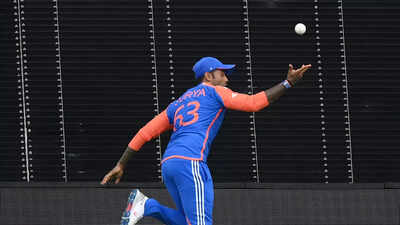The International Cricket Council (ICC) has unveiled a series of significant changes to the playing conditions across Test, One Day International (ODI), and Twenty20 International (T20I) formats. These adjustments address issues such as over rates, ball usage, boundary catches, concussion substitutes, and the adjudication of wide balls.

Image credit: ICC
To combat slow over rates, the stop clock rule, previously tested in white-ball cricket, will be permanently implemented in Test matches. The fielding team must commence the next over within 60 seconds of the completion of the previous one. Teams will be issued two warnings per innings, with subsequent breaches resulting in a five-run penalty. These warnings will reset every 80 overs, coinciding with the availability of a new ball.
In ODIs, the use of two balls will now be restricted to the initial 34 overs. For the remaining 16 overs, the fielding side will have the option to choose one of the two balls to continue play. This modification aims to manage the wear and tear of the ball more efficiently.
A new regulation has been introduced concerning boundary catches. Fielders making airborne contact with the ball beyond the boundary must ensure their initial point of contact with the ground is within the field of play to constitute a legal catch. If a fielder steps outside the boundary and jumps again, they are allowed only one additional touch before landing inside the boundary.
Teams are now obligated to pre-nominate concussion substitutes. Any player diagnosed with a concussion will be required to undergo a mandatory seven-day rest period before being permitted to return to competitive play.
A trial of a revised wide ball rule is set to take place in white-ball cricket. The batter's position at the point of delivery—rather than any subsequent movement—will serve as the point of reference for determining wides. Deliveries passing between the leg stump and the extended protected area marker at the popping crease will no longer be called wide. However, deliveries passing behind the batter's legs may still be considered wide. To aid umpires, the protected area marker will be extended to the popping crease, providing a clear visual guide.
The Decision Review System (DRS) will now utilize the actual physical outline of the stumps and bails to define the wicket zone, thereby improving the accuracy of LBW decisions.
In addition to the existing five-run penalty for a deliberate short run, the fielding team will now have the right to choose which batter takes strike for the subsequent delivery.
In domestic first-class cricket, a player who sustains a serious on-field injury at any stage after the match has commenced (including during warm-ups) can be replaced by a like-for-like player for the duration of the game.
The new Test playing conditions came into effect on June 17, with the Sri Lanka vs. Bangladesh Test. The revised ODI and T20I rules were implemented from the same series, beginning with the first ODI on July 2 and the T20Is from July 10. All international matches scheduled beyond these dates will be played under the updated regulations.
Newer articles
Older articles
 Esha Gupta Sets Record Straight: Actress Addresses Hardik Pandya Dating Rumors
Esha Gupta Sets Record Straight: Actress Addresses Hardik Pandya Dating Rumors
 Google Maps to Boost Navigation Accuracy with Fused Orientation Provider API
Google Maps to Boost Navigation Accuracy with Fused Orientation Provider API
 Global Vaccination Rates Plunge: Millions of Children Now Vulnerable to Preventable Diseases
Global Vaccination Rates Plunge: Millions of Children Now Vulnerable to Preventable Diseases
 Rishabh Pant: Greg Chappell Hails India Star as Cricket Revolutionary
Rishabh Pant: Greg Chappell Hails India Star as Cricket Revolutionary
 Skin Cancer Alert: How to Identify Suspicious Moles and Early Warning Signs
Skin Cancer Alert: How to Identify Suspicious Moles and Early Warning Signs
 Gavaskar Calls for Kuldeep Yadav's Inclusion in Second Test Amid Bumrah Fitness Concerns
Gavaskar Calls for Kuldeep Yadav's Inclusion in Second Test Amid Bumrah Fitness Concerns
 Is Daily Pooping a Must? Understanding Bowel Regularity and When to Worry
Is Daily Pooping a Must? Understanding Bowel Regularity and When to Worry
 Suryakumar Yadav's Sports Hernia: Understanding the Injury, Recovery, and Risk Factors for Athletes
Suryakumar Yadav's Sports Hernia: Understanding the Injury, Recovery, and Risk Factors for Athletes
 Vijay Sethupathi Apologizes Amid Controversy Over Son Surya's Debut Film 'Phoenix' and Alleged Video Removal Pressure
Vijay Sethupathi Apologizes Amid Controversy Over Son Surya's Debut Film 'Phoenix' and Alleged Video Removal Pressure
 Install Baccarat Hack Tool: The Secret to Winning
Install Baccarat Hack Tool: The Secret to Winning